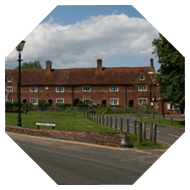
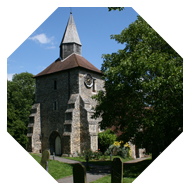
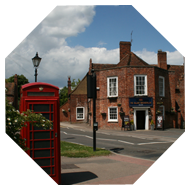
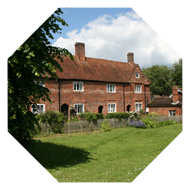
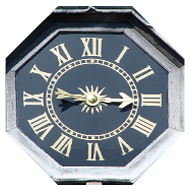
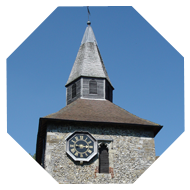
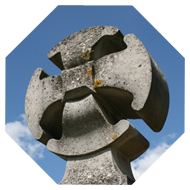
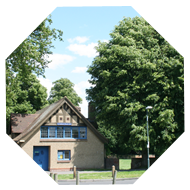

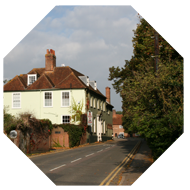
Historic St.Stephen's : Hales Place, St.Stephen's, Hackington, Canterbury
extracts from a leaflet written by the late Christopher Buckingham
Sir Edward, 3rd Baronet Hales of Woodchurch, bought the Elizabethan mansion, Place House, in 1675 from Colonel Thomas Culpeper whose father had bought it from the Manwoods. This mansion was replaced in 1766-68 by ‘a new sumptuous edifice built on a more suitable site’ [Seymour, A New Topographical, Historical &Commercial Survey of Kent, 1776] by Sir Edward, 5th Baronet. The new mansion house, ‘more fit for the residence of a monarch than for a simple country gentleman’ [Cozens, Through the Isle of Thanet, &c., 1793] was fronted by a terrace overlooking the City and the Cathedral. On the southern side of the house, now named ‘Hales Place’ was a large chapel: the Roman Catholics of the area attended services there. The Hales family in the days of Edward, 1st Baronet Hales [died 1654], had been the wealthiest in Kent but, from the time of the Civil Wars, more of their properties in Kent and elsewhere were increasingly being sold to raise money. The building of the new mansion exacerbated the on-coming poverty.
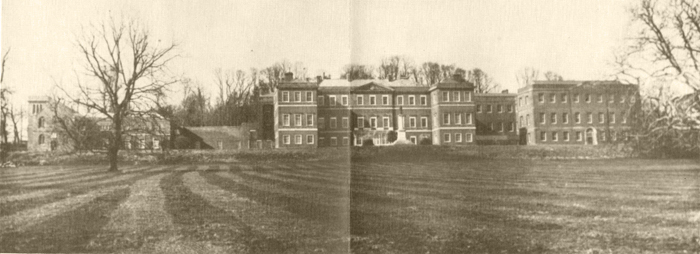
After Sir Edward died in 1802 he was succeeded by his son, the sixth baronet, at whose death in 1829 the Baronetcy became extinct. The alienated estates passed to the son of his youngest sister, Eduard de Morlaincourt, who changed his name to Edward Hales. His only daughter, Mary Barbara Felicity, inherited the property in 1837 when she was only one year old.
Educated in a French convent, MBF became an inconveniently religious woman and, when she came to of age, became a novice in the Carmelite convent in Paris. Determined to build a convent in Hales Palace, after she had been professed and taken the solemn vows of poverty, chastity and obedience, she transferred from Paris to the English Carmelite convent at Valognes. Although a nun under the vow of poverty, she returned to Hales Place and started to build the convent; she attempted - until her self-willed and uncompromising temperament ruined the plan - to bring the Carmelite nuns to Canterbury. Having failed in her first scheme, she succeeded in getting a dispensation from her vows of obedience and poverty: she had never been obedient and could hardly be called poor. She then started a Benedictine Priory on the partially-built Carmelite structure. In 1880 she declared herself bankrupt and the last of her estate, Hales Place, was sold to the Jesuits from Lyons. They greatly extended the mansion house on the northern side to form ‘St Mary’s College’.
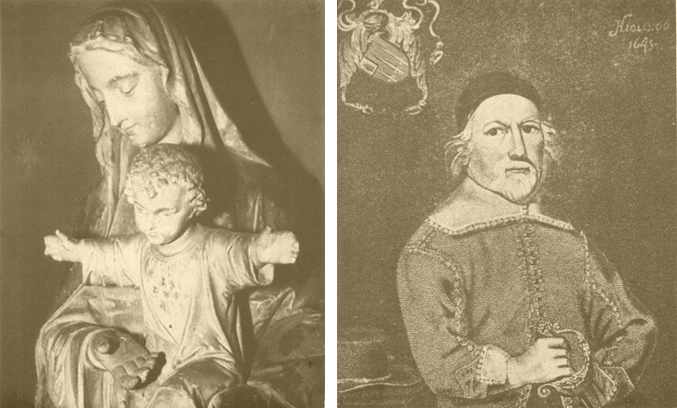
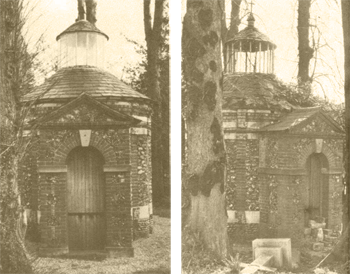
Further note - The Friends of Hales Place Chapel raised funds to help keep it in good decorative order but the group ceased to exist in the 1990s. The remaining funds, £1290, have recently been passed on to the Canterbury City Council. Currently, CCC has scaffolding around the chapel and will use the extra money to fund some ground work. Is anyone interested in forming a new ‘Friends of the Hales Place Chapel Group’? Perhaps this could mean asking for donations of about five pounds a year to help keep this lovely little listed building in good repair? It could be opened to visitors again, as used to happen. It wouldn’t be a great commitment as CCC is fully aware of the need to keep the chapel weatherproof and safe, but money in local government is very tight at the moment and it would be lovely to help safeguard its future and to involve local people in doing so. Contact Pauline Walters via the contact page form for further details.

The New Mansion House, extended by the Society of Jesus
After Sir Edward died in 1802 he was succeeded by his son, the sixth baronet, at whose death in 1829 the Baronetcy became extinct. The alienated estates passed to the son of his youngest sister, Eduard de Morlaincourt, who changed his name to Edward Hales. His only daughter, Mary Barbara Felicity, inherited the property in 1837 when she was only one year old.
Educated in a French convent, MBF became an inconveniently religious woman and, when she came to of age, became a novice in the Carmelite convent in Paris. Determined to build a convent in Hales Palace, after she had been professed and taken the solemn vows of poverty, chastity and obedience, she transferred from Paris to the English Carmelite convent at Valognes. Although a nun under the vow of poverty, she returned to Hales Place and started to build the convent; she attempted - until her self-willed and uncompromising temperament ruined the plan - to bring the Carmelite nuns to Canterbury. Having failed in her first scheme, she succeeded in getting a dispensation from her vows of obedience and poverty: she had never been obedient and could hardly be called poor. She then started a Benedictine Priory on the partially-built Carmelite structure. In 1880 she declared herself bankrupt and the last of her estate, Hales Place, was sold to the Jesuits from Lyons. They greatly extended the mansion house on the northern side to form ‘St Mary’s College’.

Madonna and child, - statue in the Hales Place Chapel Sir Edward, 1st Baronet Hales
Slightly above and to the north-west of the house, the old dove cote-this is its nomenclature on the 1840 Tithe Commutation Map: Seymour [op.cit.] refers to it in 1776 as a belvedere-had been converted by Miss Hales into a small chapel. The circular building with its curious construction, using flint and brick and decorated with animal knuckle bones, was converted by the Jesuits into a mortuary chapel.
The Chapel, before and after restoration
In 1928-29, four years after the Jesuits had returned to France, the buidlings of the estate were demolished. The ‘petite chapelle rustique’ in the cemetery in which the mortal remains of Sir Edward, 5th Baronet Hales, the Dowager Lady Frances and Mary Barbara Felicity Hales, removed from the house chapel, are buried, was given to the Catholic Parish of Canterbury. Mass was celebrated there annually as promised by the then Catholic priest but the whole property slowly fell into disuse and became a victim of the weather and of vandals. It is now thoroughly restored and since 1984 the property of the Canterbury City Council. It is used as a centre for ecumenical worship.
by Christopher Buckingham, March 1988, now deceased.
An extended version of this short account was published in "Bygone Kent", vol.8, no.12. (December 1987).
by Christopher Buckingham, March 1988, now deceased.
An extended version of this short account was published in "Bygone Kent", vol.8, no.12. (December 1987).
Further note - The Friends of Hales Place Chapel raised funds to help keep it in good decorative order but the group ceased to exist in the 1990s. The remaining funds, £1290, have recently been passed on to the Canterbury City Council. Currently, CCC has scaffolding around the chapel and will use the extra money to fund some ground work. Is anyone interested in forming a new ‘Friends of the Hales Place Chapel Group’? Perhaps this could mean asking for donations of about five pounds a year to help keep this lovely little listed building in good repair? It could be opened to visitors again, as used to happen. It wouldn’t be a great commitment as CCC is fully aware of the need to keep the chapel weatherproof and safe, but money in local government is very tight at the moment and it would be lovely to help safeguard its future and to involve local people in doing so. Contact Pauline Walters via the contact page form for further details.
Friends of the Hales Place Chapel Group
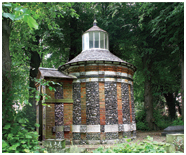 Currently, Canterbury City Council has scaffolding around the Belvedere Chapel off Tenterden Drive and is planning to use the money raised by The Friends of Hales Place Chapel, which ceased to exist in the 1990s, to fund some ground work. Is anyone interested in forming a new ‘Friends of the Hales Place Chapel Group’? Perhaps this could mean asking for donations of about five pounds a year to help keep this lovely little listed building in good repair? It could be opened to visitors again, as used to happen. It wouldn’t be a great commitment as CCC is fully aware of the need to keep the chapel weatherproof and safe, but money in local government is very tight at the moment and it would be lovely to help safeguard its future and to involve local people in doing so. If you are interested in helping, or just finding out more about the chapel, please get in touch with the Pauline Walters via the form on the Contact Page. Read more about the history of Hales Place, as written by the late Christopher Buckingham in our history pages : The History of Hales Place
Currently, Canterbury City Council has scaffolding around the Belvedere Chapel off Tenterden Drive and is planning to use the money raised by The Friends of Hales Place Chapel, which ceased to exist in the 1990s, to fund some ground work. Is anyone interested in forming a new ‘Friends of the Hales Place Chapel Group’? Perhaps this could mean asking for donations of about five pounds a year to help keep this lovely little listed building in good repair? It could be opened to visitors again, as used to happen. It wouldn’t be a great commitment as CCC is fully aware of the need to keep the chapel weatherproof and safe, but money in local government is very tight at the moment and it would be lovely to help safeguard its future and to involve local people in doing so. If you are interested in helping, or just finding out more about the chapel, please get in touch with the Pauline Walters via the form on the Contact Page. Read more about the history of Hales Place, as written by the late Christopher Buckingham in our history pages : The History of Hales Place
 Currently, Canterbury City Council has scaffolding around the Belvedere Chapel off Tenterden Drive and is planning to use the money raised by The Friends of Hales Place Chapel, which ceased to exist in the 1990s, to fund some ground work. Is anyone interested in forming a new ‘Friends of the Hales Place Chapel Group’? Perhaps this could mean asking for donations of about five pounds a year to help keep this lovely little listed building in good repair? It could be opened to visitors again, as used to happen. It wouldn’t be a great commitment as CCC is fully aware of the need to keep the chapel weatherproof and safe, but money in local government is very tight at the moment and it would be lovely to help safeguard its future and to involve local people in doing so. If you are interested in helping, or just finding out more about the chapel, please get in touch with the Pauline Walters via the form on the Contact Page. Read more about the history of Hales Place, as written by the late Christopher Buckingham in our history pages : The History of Hales Place
Currently, Canterbury City Council has scaffolding around the Belvedere Chapel off Tenterden Drive and is planning to use the money raised by The Friends of Hales Place Chapel, which ceased to exist in the 1990s, to fund some ground work. Is anyone interested in forming a new ‘Friends of the Hales Place Chapel Group’? Perhaps this could mean asking for donations of about five pounds a year to help keep this lovely little listed building in good repair? It could be opened to visitors again, as used to happen. It wouldn’t be a great commitment as CCC is fully aware of the need to keep the chapel weatherproof and safe, but money in local government is very tight at the moment and it would be lovely to help safeguard its future and to involve local people in doing so. If you are interested in helping, or just finding out more about the chapel, please get in touch with the Pauline Walters via the form on the Contact Page. Read more about the history of Hales Place, as written by the late Christopher Buckingham in our history pages : The History of Hales Place

